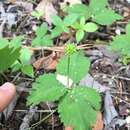pt-BR
nomes no trilho de navegação


Anemone deltoidea (lat. Anemone deltoidea) - qaymaqçiçəyikimilər fəsiləsinin əsmə cinsinə aid bitki növü.
Anemone deltoidea (lat. Anemone deltoidea) - qaymaqçiçəyikimilər fəsiləsinin əsmə cinsinə aid bitki növü.
Anemonastrum deltoideum, also known by the common names Columbian windflower and western white anemone, is a species of flowering plant in the buttercup family Ranunculaceae. It is native to the forests of the west coast of the United States. This is a rhizomatous perennial herb growing between 10 and 30 centimeters tall. There is usually a single basal leaf which is divided into three large toothed leaflets, each up to 6 centimeters long. There may be more leaves along the mostly naked stem which are similar in appearance to the leaflets on the basal leaf. The inflorescence has three leaflike bracts and a single flower. The flower has no petals but five petal-like white sepals each one to two centimeters long. There are up to 120 whiskery stamens and many pistils. The fruit is a cluster of spherical achenes.[2][3]
Anemonastrum deltoideum, also known by the common names Columbian windflower and western white anemone, is a species of flowering plant in the buttercup family Ranunculaceae. It is native to the forests of the west coast of the United States. This is a rhizomatous perennial herb growing between 10 and 30 centimeters tall. There is usually a single basal leaf which is divided into three large toothed leaflets, each up to 6 centimeters long. There may be more leaves along the mostly naked stem which are similar in appearance to the leaflets on the basal leaf. The inflorescence has three leaflike bracts and a single flower. The flower has no petals but five petal-like white sepals each one to two centimeters long. There are up to 120 whiskery stamens and many pistils. The fruit is a cluster of spherical achenes.
Anemone deltoidea es una herbácea de la familia de las ranunculáceas. Es nativa de los bosques de la costa oeste de los Estados Unidos.
Es una planta herbácea rizomatosa y perennifolia que alcanza un tamaño de entre 10 y 30 centímetros de altura. Normalmente tiene una sola hoja basal, que se divide en tres grandes volantes dentados, cada uno de hasta 6 centímetros de largo. Puede tener más hojas a lo largo del tallo principalmente desnudo que son similares en apariencia a las valvas de la hoja basal. La inflorescencia tiene tres brácteas semejantes a hojas y una flor única. La flor tiene cinco pétalos blancos, como los sépalos de uno a dos centímetros de largo. El fruto es un racimo de aquenios esféricos.
Anemone deltoidea, fue descrita por David Douglas y publicado en Flora Boreali-Americana 1(1): 6, pl. 3, f. A, en el año 1829.[1]
Anemone: nombre genérico que procede de la palabra griega Άνεμος, que significa viento.
deltoidea: epíteto latíno que significa "con forma de delta".[2]
Anemone deltoidea es una herbácea de la familia de las ranunculáceas. Es nativa de los bosques de la costa oeste de los Estados Unidos.